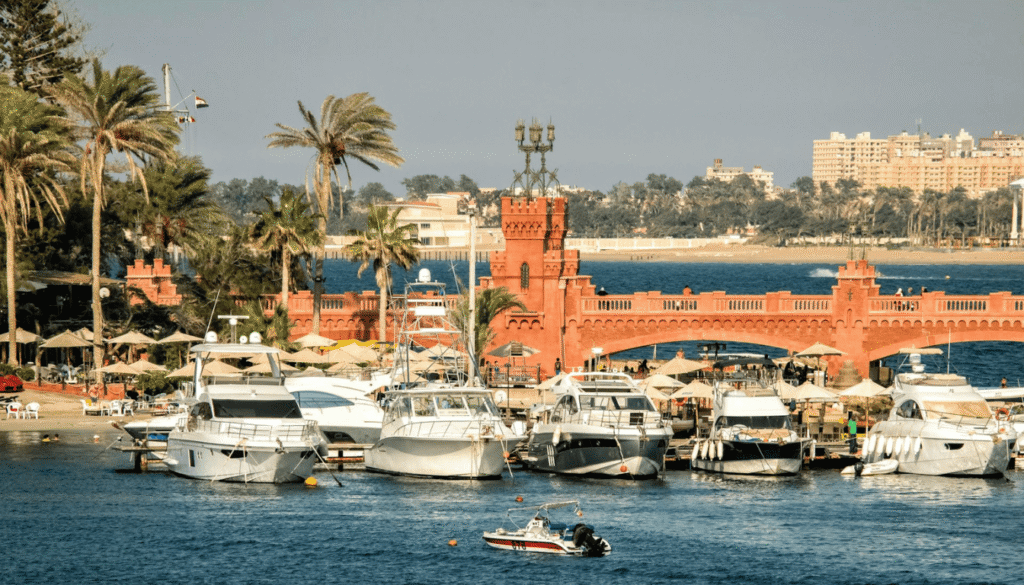Why Alexandria is the Pearl of the Mediterranean
There’s something magnetic about Alexandria that makes it unlike anywhere else in Egypt. While Cairo pulses with its desert energy and Luxor whispers ancient secrets, Alexandria spreads itself along the Mediterranean coast with an entirely different personality. This is Egypt’s second-largest city, but it feels worlds apart from the rest of the country.
Walking through Alexandria’s streets, you’ll notice the layers of history stacked like pages in a book. Greek columns stand beside Islamic mosques. Roman ruins peek out from beneath modern buildings. French-style cafés serve Arabic coffee. It’s this cultural cocktail—this incredible blend of Greek, Roman, Egyptian, and even European influences—that makes the top attractions in Alexandria so captivating.
Whether you’re the type who gets lost in museum corridors, lives for that perfect beach sunset, or travels primarily through your taste buds, Alexandria delivers. The city manages to be both grand and intimate, ancient and refreshingly modern. You can explore underground tombs in the morning, swim in the Mediterranean by afternoon, and feast on the freshest seafood as the sun melts into the sea.
What makes Alexandria Egypt attractions truly special is how they tell a continuous story. Each site connects to the next, weaving together centuries of human achievement, ambition, and creativity. This isn’t a city frozen in time—it’s very much alive, breathing, and ready to share its secrets with anyone curious enough to look.
A Glimpse into Alexandria’s Illustrious Past (Founded 331 BC)
Every great city has an origin story, but Alexandria’s reads like something from a novel. Its history doesn’t just inform the best places to visit in Alexandria—it is the reason these places exist.
Who Founded Alexandria and When?
Picture this: It’s 331 BC, and a young Macedonian king named Alexander the Great stands on a strip of land between the Mediterranean Sea and Lake Mariut. He’s just conquered Egypt, and he’s dreaming big. Alexander envisioned a city that would connect East and West, a place where cultures could collide and create something entirely new.
The king personally walked the city’s perimeter, using barley grains to mark where the walls should rise (or so the legend goes). He never lived to see his namesake city flourish—Alexander died just eight years later—but his vision became reality under the rule of Ptolemy I, one of his generals who claimed Egypt as his own kingdom.
What started as Alexander’s dream became the ancient world’s most cosmopolitan city. At its peak, Alexandria housed nearly half a million people—Greeks, Egyptians, Jews, Romans, Persians—all mixing together in ways that were revolutionary for their time.
The Lighthouse of Pharos: Alexandria’s Lost Wonder
If you’ve read any Alexandria travel guide, you’ve probably seen artistic renderings of the Lighthouse of Pharos. This wasn’t just any lighthouse—it was one of the Seven Wonders of the Ancient World, standing somewhere between 100 and 130 meters tall (sources differ, but either way, it was massive for its time).
Built around 280 BC on the island of Pharos, the lighthouse guided ships safely into Alexandria’s harbor for over a thousand years. Imagine that longevity. Empires rose and fell, religions spread across continents, and still that lighthouse stood, its fire burning night after night.
The structure itself was an engineering marvel—three tiers of decreasing size, topped with a statue (probably of Poseidon or Zeus), and a mirror system that could reflect sunlight during the day and project firelight at night. Sailors claimed they could see its beam from 50 kilometers away.
Earthquakes eventually brought it down between the 12th and 14th centuries. The ruins tumbled into the sea, where they remained hidden until underwater archaeologists started mapping them in the 1990s. Today, Qaitbay Citadel stands on the exact spot, and if you visit, you’re literally standing where one of humanity’s greatest architectural achievements once pierced the sky.
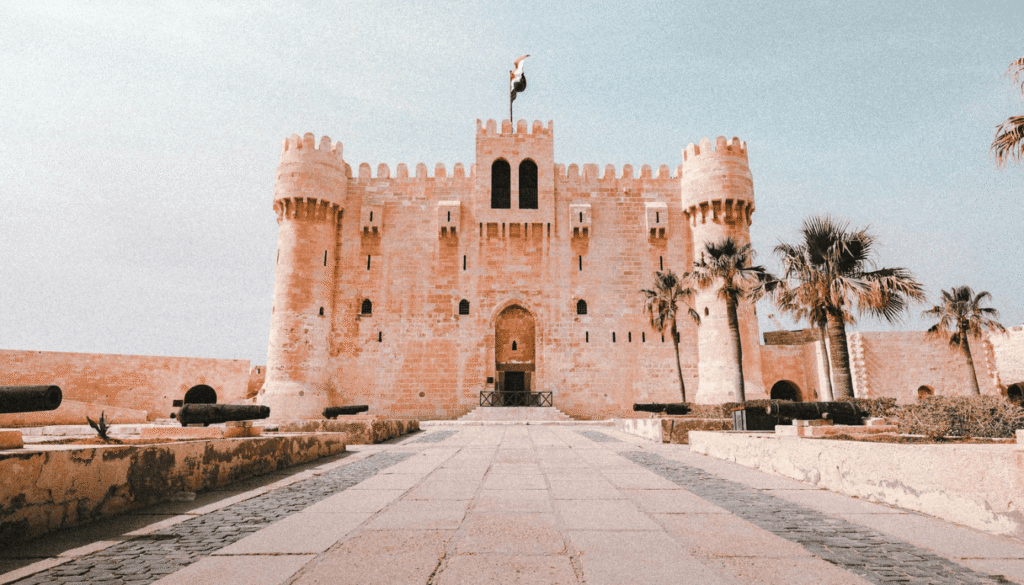
“Book Your Trip to Qaitbay Citadel Today and Step Into Alexandria’s Glorious Past!”
The Great Library: A Beacon of Ancient Knowledge
While the Lighthouse guided ships, the Great Library of Alexandria guided minds. This wasn’t just a building full of scrolls—it was the ancient world’s Google, Wikipedia, and Harvard all rolled into one.
Founded in the 3rd century BC, the Library aimed to collect all the world’s knowledge. Scholars estimate it housed between 400,000 and 700,000 scrolls at its peak. Every ship that docked in Alexandria had to surrender its books for copying. The Library kept the originals and returned the copies—a bit cheeky, but effective for building a collection.
The greatest minds of the ancient world worked here. Euclid developed his geometry. Eratosthenes calculated Earth’s circumference with remarkable accuracy. Archimedes studied here. The Library wasn’t just preserving knowledge—it was actively creating it.
How exactly it was destroyed remains one of history’s frustrating mysteries. Fire played a role (possibly during Julius Caesar’s campaign in 48 BC, though that’s debated). Funding likely dried up. Religious tensions may have contributed. Whatever the cause, one of humanity’s greatest repositories of knowledge vanished, taking countless texts with it—many of which we’ll never recover.
The modern Bibliotheca Alexandrina, which we’ll explore shortly, stands as both tribute and continuation of this ancient dream.
Top Attractions in Alexandria: Walking Through History
Now let’s get to the heart of why you’re reading this—the places you absolutely need to experience. These aren’t just tourist stops; they’re portals into different eras of human civilization.
1. Bibliotheca Alexandrina: The Modern Marvel of Knowledge
The Bibliotheca Alexandrina doesn’t try to recreate the ancient Library—it reimagines it for our time. Opened in 2002, this architectural stunner sits near where historians believe the original Library once stood.
From the outside, the building looks like a massive tilted cylinder emerging from the earth, its walls covered in letters from 120 different writing systems. The symbolism hits you immediately: knowledge transcends languages and cultures.
Inside, the main reading room will take your breath away. It’s one of the largest open reading spaces in the world, descending in terraced levels and lit by filtered Mediterranean sunlight. The space feels both intimate and vast—you can lose yourself in a book while sitting among thousands of others doing the same.
But this is so much more than a library. The complex houses four museums: the Antiquities Museum showcases artifacts from Egyptian history; the Manuscript Museum displays rare texts and illuminated pages; the Sadat Museum honors the former Egyptian president; and the Science Museum brings interactive exhibits for curious minds of all ages.
Don’t miss the Planetarium—it’s the most technologically advanced in the Middle East. The art galleries rotate exhibitions featuring both Egyptian and international artists. There’s even a dedicated space for the visually impaired, continuing Alexandria’s tradition of making knowledge accessible to all.
Pro tip: Visit on a weekday morning when the reading room is less crowded. The quiet concentration of hundreds of people reading together creates an almost meditative atmosphere.
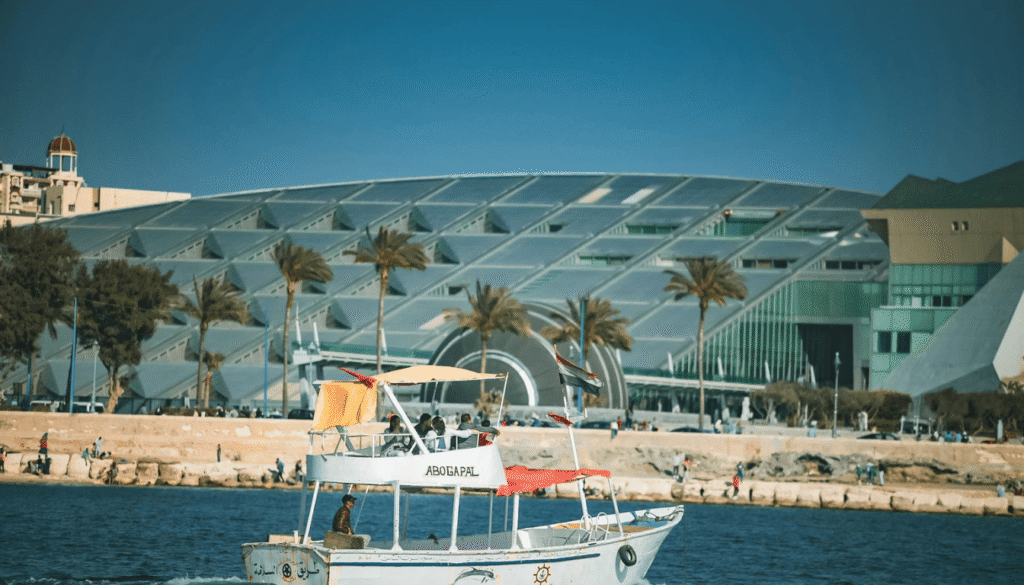
2. Qaitbay Citadel: A 15th-Century Fortress Overlooking the Sea
Standing at the tip of a narrow peninsula, Qaitbay Citadel commands the harbor entrance with defensive authority. Sultan Qaitbay built this fortress in 1477, using stones from the collapsed Lighthouse of Pharos—so in a way, you’re still experiencing that ancient wonder, just rearranged.
The fortress is classic Mamluk military architecture: thick walls, strategic towers, and a commanding position that gave defenders clear sightlines in all directions. Walk through its maze of rooms and corridors, climb to the upper levels, and you’ll understand why this spot has been militarily significant for over two millennia.
What makes Qaitbay truly special are the panoramic views. Stand on the ramparts with the Mediterranean stretching endlessly before you, waves crashing against ancient stones below. On one side, you’ll see Alexandria’s modern shoreline curving away; on the other, fishing boats bob in the harbor just as they have for centuries.
The citadel has been a naval base, a prison, and now a museum. Its exhibits cover the fortress’s history and maritime heritage, though honestly, the building itself is the main attraction. Come during late afternoon when the sun begins its descent—the light turns golden, the tourist crowds thin out, and you can almost hear the whispers of history in the sea breeze.
3. Descending into the Catacombs of Kom El Shoqafa
This is where Alexandria Egypt attractions get genuinely unique. The Catacombs of Kom El Shoqafa represent the kind of cultural fusion you won’t find anywhere else in the world—a labyrinth of underground tombs where Egyptian, Greek, and Roman artistic traditions merge into something entirely original.
Discovered by accident in 1900 (a donkey fell through the ground, revealing the entrance), these catacombs date from the 2nd century AD. They were carved from solid rock on three levels, though the lowest level is now submerged by groundwater.
Descend the spiral staircase, and you enter a world where cultures collide in the most fascinating ways. Look at the tomb decorations closely: you’ll see Egyptian gods dressed in Roman armor. Anubis and Horus wearing military garb. Greek-style columns supporting chambers designed for mummification. It’s religious syncretism carved in stone.
The main tomb features a stunning vestibule with columns and niches holding statues. Beyond that lies the principal burial chamber, where a massive sarcophagus sits surrounded by carved scenes depicting Egyptian funerary rites—but rendered in a distinctly Greco-Roman style.
The Hall of Caracalla contains a mass grave, possibly for Christian martyrs or victims of religious persecution. Niches carved into the walls once held hundreds of bodies, each wrapped and sealed in the rock.
The atmosphere down here is heavy with history. The air is cool and slightly damp. Light filters through in strategic places, highlighting particular carvings. It’s one of those places that makes you feel the weight of centuries, reminding you that people have been dealing with death, memory, and the desire to be remembered since the beginning of civilization.
Fair warning: If you’re claustrophobic, this might challenge you. But if you can handle it, the Catacombs are absolutely essential to understanding Alexandria’s multicultural soul.
4. Pompey’s Pillar and the Ruins of the Serapeum
Don’t let the name fool you—Pompey’s Pillar has nothing to do with Pompey the Great. This massive red granite column, standing nearly 27 meters tall, was actually erected around 297 AD to honor the Roman Emperor Diocletian. Medieval Crusaders mistakenly believed it marked Pompey’s burial place, and the incorrect name stuck.
Still, what a column. It’s carved from a single piece of Aswan granite, weighing about 285 tons. Just transporting and erecting it would be an engineering challenge today—imagine accomplishing it with Roman-era technology.
The pillar stands amid the ruins of the Serapeum, a temple dedicated to Serapis (a deity created by the Ptolemies to unify Greeks and Egyptians through a shared god). In its day, this temple complex rivaled the greatest religious structures in the Roman Empire. The Serapeum housed a “daughter library” containing thousands of scrolls—essentially a branch of the Great Library.
Not much remains of the temple itself, but wandering the site gives you a sense of scale. You’ll see underground galleries that once stored sacred texts, mysterious subterranean passages, and scattered columns that hint at the complex’s former grandeur.
Look for the Nilometer—an ancient device used to measure the Nile’s flood levels, crucial information for predicting agricultural success. There are also Hellenistic sphinxes, statues, and carved stone fragments scattered around the area.
This site doesn’t draw crowds like some other attractions, which makes it perfect for contemplative exploration. Bring some water and take your time. The history here is dense, layered, and rewards patient attention.
5. Montazah Palace and Gardens: A Serene Royal Escape
After all that ancient history, let’s fast-forward to something more recent. Montazah Palace complex offers 150 hectares of gardens, beaches, and royal buildings that feel like stepping into a different era—specifically, the early 20th century when Egypt’s royalty summered here.
Khedive Abbas II built the original palace in 1892, later expanded by King Fuad I in the 1920s. The architecture is a delightful mash-up: Turkish and Florentine styles meeting in ways that somehow work beautifully. The main palace (Al-Haramlek) isn’t open to visitors—it’s now a presidential residence—but you can admire its towers, ornate details, and elegant proportions from the gardens.
The Salamlek Palace, smaller and initially built as a hunting lodge, has been converted into a luxury hotel. Even if you’re not staying there, the building itself is worth photographing.
But honestly, the gardens steal the show. This is where Alexandrians come to escape the city’s hustle. Ancient fig trees provide shade. Palm trees sway in the sea breeze. Carefully maintained flower beds burst with Mediterranean flora. Winding paths lead to hidden benches and unexpected views.
The gardens stretch down to a private beach—one of the cleanest along Alexandria’s coast. If you’re visiting during summer, bring your swimsuit. The water here is clearer than at public beaches, and swimming in the Mediterranean while gazing back at royal palaces creates a rather surreal experience.
Families flock here on weekends, and the atmosphere becomes festive: kids playing, couples picnicking, groups of friends grilling fish by the shore. It’s wholesome, joyful, and distinctly Egyptian—a reminder that the best places to visit in Alexandria aren’t just about dusty ruins, but about experiencing how people actually live and relax.
Entry is refreshingly affordable (around 25 Egyptian pounds for Egyptians, more for foreign tourists), and the grounds are vast enough that it never feels overcrowded. Come in late afternoon, stay for sunset, and watch the sky turn impossible shades of orange and purple over the sea.
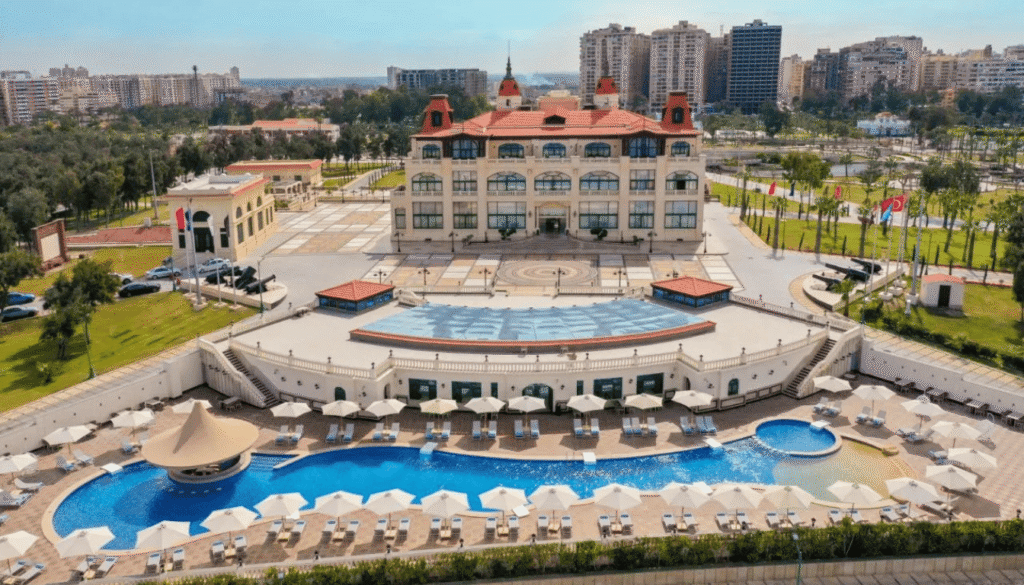
“Book Your Alexandria Hotel Now and Wake Up to Stunning Mediterranean Views!”
Exploring the Corniche and Best Beaches for Swimming
Alexandria’s relationship with the Mediterranean isn’t casual—it’s definitional. The sea shaped this city’s history, economy, culture, and daily rhythm. To understand Alexandria, you need to experience its coastline.
What to See and Do Along the Alexandria Corniche
The Corniche is Alexandria’s living room—a 15-kilometer promenade stretching along the Eastern Harbor where the city comes out to breathe, socialize, and live. This isn’t a tourist attraction in the traditional sense; it’s where Alexandria happens.
Start your Corniche walk near Stanley Bridge in the east, or begin at Qaitbay Citadel in the west—either direction works. What matters is taking your time, because the Corniche is about observation, not destination.
You’ll pass fishermen casting lines from the seawall, their buckets slowly filling with the day’s catch. Street vendors sell roasted corn, sweet potato, and lupini beans from mobile carts. Cafés spill out onto the sidewalk, their tables packed with men playing backgammon over tiny cups of thick coffee.
The Corniche is bustling with life day and night, but its character shifts with the hours. Mornings bring joggers and elderly couples taking constitutional walks. Afternoons see families claiming spots along the wall, kids dangling their legs over the edge while parents keep watchful eyes. Evenings transform the Corniche into something almost festive—couples strolling arm-in-arm, friend groups laughing over shared meals, street musicians providing soundtrack to the sunset.
Architecture fans will appreciate the variety: turn-of-the-century European-style buildings (many sadly deteriorating), mid-century apartment blocks, and shiny new hotels all competing for sea views. The styles shouldn’t work together, but somehow they create a uniquely Alexandrian aesthetic.
Stop at one of the old-school cafés like Trianon or Délices (we’ll discuss these more in the food section) for a glimpse into Alexandria’s cosmopolitan past. These establishments have barely changed since the 1920s, when the city was populated by Greeks, Italians, and French alongside Egyptians, all mixing in these very same spaces.
The sea itself is ever-present: its smell, its sound, its mood. On calm days, the Mediterranean shimmers like hammered silver. When storms roll in, waves crash spectacularly against the Corniche wall, sending spray high enough to soak unwary pedestrians on the sidewalk.
Pro tip: Walk the Corniche twice—once during the day to see the details and people-watch, once at night when the lights reflect off the water and the city reveals its romantic side.
Designated Swimming Spots: Maamoura, Stanley, and Montazah Beaches
Let’s be clear about something important: Alexandria’s relationship with swimming is complicated. This is a working harbor city, and water quality varies significantly depending on where you are. The key is sticking to designated swimming spots where the water is regularly monitored and generally clean.
Maamoura Beach sits in the eastern suburbs, about 20 kilometers from downtown. This is where many Alexandrians go when they want a proper beach day. The sand is decent (by Mediterranean standards, not by Maldives standards—manage expectations), and the water is usually clear. Weekends get crowded, especially during summer when half of Cairo seems to descend on Alexandria’s beaches. Weekdays are much more pleasant. The beach has both public sections (free but packed) and private sections (small fee, more facilities, less crowded).
Stanley Beach is far more accessible if you’re staying in central Alexandria, located along the Corniche near the distinctive Stanley Bridge. This stretch features the famous Stanley Beach with its Mediterranean café culture. The beach itself is narrow, but the atmosphere is wonderful—very local, very authentic. You’ll find families setting up elaborate picnics, vendors selling everything from inflatable toys to grilled corn, and a general sense of seaside joy. The water here is usually safe for swimming, though waves can be strong. There are both public and private sections, with the private clubs offering changing rooms, umbrellas, and beach chairs for reasonable fees.
Montazah Beach, attached to the royal gardens we discussed earlier, offers probably the cleanest water along Alexandria’s coast. It’s protected, well-maintained, and feels almost secluded despite being in a city of five million people. The beach has both free public access and private sections. The water here is clear enough to actually see your feet, which isn’t guaranteed at other Alexandria beaches.
A crucial safety note: Only swim in designated areas with lifeguards present. Alexandria’s coastline includes rocky sections, strong currents, and areas where the water quality is questionable. Don’t be the tourist who ignores local wisdom and ends up with an avoidable problem.
Also, understand that Alexandria’s beaches are not secluded. This is social swimming—families, friend groups, lots of activity and noise. If you’re dreaming of a pristine, quiet beach experience, you might want to head to Egypt’s Red Sea resorts instead. But if you want to experience how millions of Egyptians enjoy their Mediterranean coast, Alexandria’s designated beaches deliver exactly that.
Beach culture here is conservative by Western standards. While you’ll see some women in swimsuits, many swim fully clothed or in modest swimwear. Foreign tourists wearing typical beach attire won’t face problems at the major beaches, but err on the side of modesty if you’re uncertain.
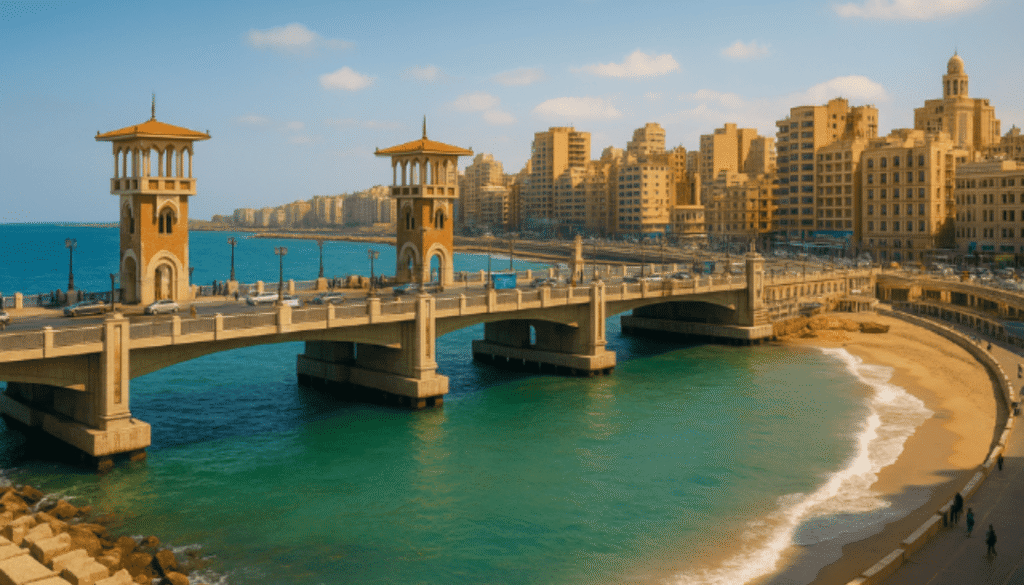
“Book now best hotel in Alexandria (Tolip Royal Alexandria).”
Essential Cultural Offerings in Egypt’s Intellectual Hub
Alexandria’s identity as Egypt’s intellectual and cultural center isn’t just historical—it’s ongoing. The city maintains its role as a place where ideas, art, and scholarship matter.
Alexandria National Museum: 1,800 Artifacts Across Time
Located in a beautifully restored Italian-style palace, the Alexandria National Museum does something clever: it tells Egypt’s entire story through Alexandria’s lens. The museum houses over 1,800 artifacts arranged chronologically across three floors, each representing a different era.
The basement level covers Pharaonic Egypt, displaying items from the Old Kingdom through the Late Period. You’ll see sphinxes, statues of gods and pharaohs, everyday objects, and funerary items. What makes this collection special is that all these artifacts have Alexandria connections—they were found in the city or nearby, reminding us that Egyptian civilization extended all the way to the Mediterranean coast.
The ground floor focuses on the Greco-Roman period, Alexandria’s golden age. Here you’ll find spectacular statues showing the fusion of Greek and Egyptian artistic styles—Egyptian gods rendered with Greek naturalism, royal portraits blending Ptolemaic and pharaonic iconography. There are coins, jewelry, glassware, and even underwater finds from Alexandria’s submerged palaces and the Pharos Lighthouse.
The first floor covers Islamic, Coptic, and modern periods. Islamic ceramics, Coptic textiles, weaponry, Ottoman-era furnishings, and items from Egypt’s royal period (including photographs and personal effects) round out the narrative. There’s even a section on Egypt’s modern history, bringing the story right up to the present.
The museum is manageable—you can see everything properly in about two hours, maybe three if you’re a detail person. English signage is decent, though not always perfect. The building itself is beautiful, with original architectural details preserved throughout.
Visit on a weekday morning to avoid school groups. The gift shop actually has some quality reproductions and books worth browsing. And unlike some Egyptian museums that can feel overwhelming in their vastness (looking at you, Cairo Egyptian Museum), this one feels human-scaled and thoughtfully curated.
Greco-Roman Museum: Significance as a Cultural Crossroads
At the time of writing, the Greco-Roman Museum remains closed for extensive renovation—a process that’s been ongoing for years. However, it’s worth mentioning because once it reopens (and it will eventually), this should be at the top of your Alexandria travel guide.
The museum was founded in 1892, making it one of the world’s first institutions specifically dedicated to the Hellenistic period. Its collection spans from the 3rd century BC through the 3rd century AD—precisely the era when Greek and Egyptian cultures were mixing most intensively.
What makes this collection unique is its focus on everyday life alongside monumental art. Yes, there are spectacular statues and architectural elements, but you’ll also see pottery, glassware, cosmetic containers, coins, and tools that reveal how ordinary people lived. The mummy collection includes Fayum portraits (those hauntingly lifelike painted portraits attached to mummies), representing one of the most important bridges between Egyptian and Roman artistic traditions.
The museum’s location, in the heart of downtown Alexandria near Gamal Abdel Nasser Street, places it within walking distance of other attractions. When it reopens, plan to spend at least two hours here—this is essential material for understanding how cultures evolve when they collide.
The Royal Jewelry Museum and the Abou El Abbas El Mursi Mosque
The Royal Jewelry Museum offers something entirely different: pure, unrestrained glamour. Housed in a palace that once belonged to Princess Fatima Al-Zahraa (a descendant of Muhammad Ali Pasha), the building alone is worth the visit—a fantasy of European decorative styles with painted ceilings, intricate woodwork, and stained glass.
The collection showcases jewelry and personal items from Egypt’s royal family spanning the Muhammad Ali dynasty. We’re talking tiaras dripping with diamonds, gold dinner services, bejeweled swords, ornate watches, and chess sets made from precious stones. Some pieces are genuinely exquisite, displaying master craftsmanship. Others are so over-the-top ostentatious that they circle back to being charming.
What’s interesting is seeing how Egypt’s royalty presented themselves—the blend of European aristocratic style with Egyptian and Ottoman influences. These weren’t people uncertain about their status; this was power displayed through material wealth.
The museum is in the Zizenia neighborhood, slightly away from central attractions. Photography inside is prohibited (for security reasons, given the collection’s value). Plan for about an hour here, maybe ninety minutes if you’re really into decorative arts.
The Abou El Abbas El Mursi Mosque represents Alexandria’s Islamic heritage. Built over the tomb of a 13th-century Sufi saint from Murcia, Spain (hence the name), the mosque is the city’s most important Islamic religious site. The current structure dates from 1929, rebuilt in neo-Mamluk style with a gorgeous Ottoman-influenced design.
The mosque features eight columns supporting an octagonal dome, ornate Arabic calligraphy, beautiful geometric tile work, and an overall sense of light and space. The exterior, with its cream-colored stone and distinctive minarets, dominates the Corniche skyline in the Anfushi neighborhood.
Non-Muslims can visit outside prayer times, but dress modestly (shoulders and knees covered; women should bring a scarf for their hair). The mosque sits in a traditionally working-class neighborhood that feels authentically Alexandrian—a nice contrast to the more tourist-oriented areas.
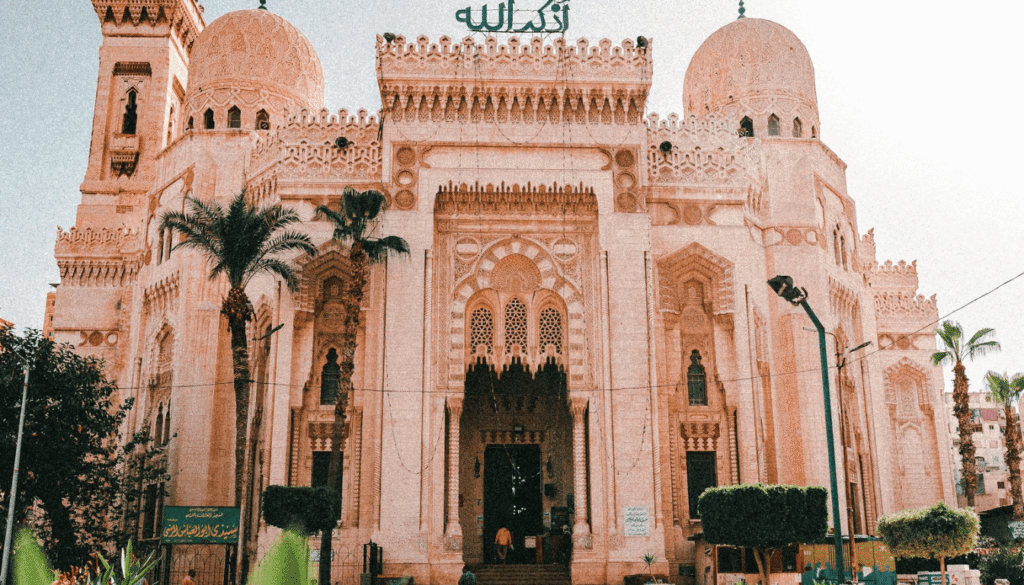
Must-Try Dishes and Essential Dining Spots in Alexandria
Let’s talk about why food lovers should include Alexandria in their travel plans. This city’s coastal location and multicultural history created a unique culinary identity—distinctly Egyptian but with its own accent.
What is Alexandrian Cuisine Famous For? (Seafood and Local Flavors)
Alexandria’s relationship with the Mediterranean goes straight to the table. While Cairo might be about kofta and pigeon, Alexandria is about what came out of the sea that morning.
Sayadeyya is Alexandria’s signature dish—fish (usually sea bass or mullet) served over rice that’s been cooked with the fish stock, tomatoes, and spices. The rice becomes this beautiful saffron-yellow color and absorbs all those intense flavors. The dish is typically topped with fried onions and pine nuts, served with a spicy tomato sauce on the side. Every family has their recipe, every restaurant claims theirs is authentic, and honestly, most versions are excellent. It’s comfort food elevated by fresh ingredients and centuries of refinement.
Alexandrian Liver is street food royalty—though don’t let the name fool you into thinking this is some refined dish. This is spicy, messy, wonderful sandwich food. Beef or lamb liver is cut into small pieces, fried with garlic, hot peppers, lemon juice, and spices until it’s crispy on the outside and tender inside, then stuffed into Egyptian baladi bread with tahini and pickles. The best vendors have been making these sandwiches in the same spot for decades. It’s cheap, filling, and slightly addictive.
Feseekh requires a specific kind of courage. This is fermented mullet fish—salted, dried, and aged for months. The result is pungent (being generous with the description), intensely salty, and definitely not for everyone. Egyptians traditionally eat feseekh during the spring festival of Sham el-Nessim, and Alexandria is famous for producing some of Egypt’s best. Fair warning: improperly prepared feseekh can cause serious food poisoning. If you’re going to try it, do so at a reputable restaurant, not from a street vendor. Many foreigners find the taste and smell overwhelming, but it’s culturally significant and represents Alexandria’s ancient preservation techniques.
Beyond these signature dishes, Alexandria excels at grilled seafood. Simple, fresh, perfectly cooked fish, shrimp, calamari, and crab. You’ll find restaurants along the Corniche that display their catch on ice—you point at what you want, they weigh it, tell you the price, and grill it to order. This is eating at its most elemental and satisfying.
Don’t overlook Alexandria’s koshari. While this mixed rice, lentils, pasta, and fried onions dish topped with tomato sauce is found throughout Egypt, Alexandrian versions often include seafood elements or slight variations that reflect the city’s coastal character.
The city also has a surprisingly strong pastry tradition, inherited from the Greek, Italian, and French communities that once thrived here. Bakeries still produce authentic baklava, croissants, and various cream-filled pastries using recipes that haven’t changed in generations.
Top Restaurants: Fresh Seafood to Historic Bakeries
Fish Market Restaurant delivers exactly what its name promises, but with style. Located on the Corniche with floor-to-ceiling windows overlooking the sea, this place lets you select your fish from the display, choose your preparation method, and enjoy views while your meal is prepared. The atmosphere skews upscale without being stuffy. Prices are higher than street food (obviously), but reasonable for the quality. The grilled seafood platter for two is generous enough for three and includes fish, shrimp, calamari, and crab. Service is professional, English-speaking staff can guide you through choices, and the location is perfect for a sunset dinner.
Abou El Sid brings traditional Egyptian cuisine to the table with an emphasis on quality and atmosphere. Part of a small Egyptian chain, this location maintains the brand’s commitment to classic dishes done properly. Think stuffed pigeon, molokhia (jute leaf stew), multiple mezze options, and excellent grilled meats. The décor leans into Egyptian nostalgia—mashrabiya screens, traditional lamps, vintage photographs—creating an experience that feels special without being tourist-oriented. Prices are mid-range, and the location in the San Stefano area makes it convenient.
Délices Patisserie is a time machine disguised as a bakery. Founded in 1922 by a Greek family, this institution continues producing French-style pastries, chocolates, and desserts that taste like Alexandria’s cosmopolitan past. The building itself is charming—high ceilings, vintage display cases, marble counters, and an atmosphere of faded elegance. The croissants are legitimately excellent (a rarity in Egypt), the millefeuille is textbook-perfect, and the chocolate quality exceeds most Egyptian standards. This is where Alexandria’s old families still come for special occasions. Prices are quite reasonable given the quality. There’s a small seating area upstairs, or you can buy boxes to go. Located on Saad Zaghloul Street in downtown, it’s perfect for a mid-exploration coffee break.
A few more recommendations worth your time:
Tikka Grill (on Gamal Abdel Nasser Street) does excellent Egyptian grilled meats in a casual, no-nonsense setting. Their mixed grill and kofta are reliably good, prices are very reasonable, and locals pack the place—always a good sign.
Sea Gull Restaurant (Corniche, near Stanley) offers rooftop dining with spectacular views. The seafood is fresh, preparation is straightforward and good, and the sunset views are worth the slightly elevated prices.
Mohamed Ahmed (multiple locations, original on Saad Zaghloul Street) is Alexandria’s most famous breakfast spot. They’ve been serving ful, falafel, and all the Egyptian breakfast staples since 1950. Cheap, authentic, always crowded with locals, and genuinely delicious. No frills, no English menu, just good food served fast. Get the mixed plate and Egyptian tea.
For street food adventures, head to Manshia neighborhood where the liver sandwich vendors cluster. Ask locals to point you toward the most popular spot—it changes, and part of the experience is the hunt.
Planning Your Trip: Logistics, Weather, and Accommodation
Let’s get practical. Alexandria is easier to navigate than Cairo and more tourist-friendly than many Egyptian cities, but a little planning prevents frustration.
When is the Best Time to Visit Alexandria, Egypt?
March through May offers Alexandria’s sweetest spot. Spring temperatures hover comfortably in the low 20s Celsius (low 70s Fahrenheit). The Mediterranean breezes are refreshing rather than cold. Gardens and parks bloom beautifully. This is peak walking weather—you can explore all day without either roasting or freezing. These months also fall outside Egypt’s main tourist season, meaning slightly lower prices and fewer crowds at major sites.
September through November provides a second ideal window. Summer’s intense heat breaks, humidity drops, and the sea remains warm enough for swimming. September can still feel quite summery (which is lovely if you want beach time), while November begins Alexandria’s cool season. Fall light does beautiful things to the city’s architecture, casting that golden glow photographers love.
Summer (June through August) brings Egyptian families from Cairo escaping the capital’s desert heat. Alexandria becomes crowded and expensive. Temperatures regularly hit 30°C (mid-80s°F), but the humidity makes it feel hotter. Beach days are certainly possible—locals flock to the shore precisely because summer is the traditional beach season. But exploring archaeological sites and walking the city becomes less pleasant. If your schedule only allows summer travel, book accommodation well in advance and embrace the slower pace dictated by heat.
Winter (December through February) surprises people. Alexandria gets genuinely cold by Egyptian standards—temperatures can drop to 10-12°C (50s°F), which might not sound extreme, but Egyptian buildings aren’t insulated or heated like Northern European ones. Add wind off the Mediterranean and it feels properly chilly. Rain is possible, though not heavy. Winter has advantages: rock-bottom prices, virtually no crowds, and a moody, romantic atmosphere as storms roll in off the sea. Just pack layers and accept you won’t be swimming.
One important note: Egyptian public holidays (especially Ramadan and Eid celebrations) significantly affect the experience. During Ramadan, many restaurants close during daylight hours, opening only after sunset. Operating hours shift throughout the city. Eid periods bring massive crowds from Cairo. Check the Islamic calendar when planning your visit.
Getting Around: Trams, Taxis, and Negotiating Fares
Alexandria has one of the world’s oldest tram networks, dating back to 1863. The historic tram system still operates along several routes, though service is… let’s say “atmospheric” rather than efficient. Trams are extremely cheap (a few Egyptian pounds), offer a genuinely local experience, and provide a charming way to cover certain routes (especially along the Corniche). However, they’re slow, crowded, and confusing if you don’t know the city. Consider riding the tram once or twice for the experience rather than as your primary transportation.
Taxis are Alexandria’s practical transportation solution. The city has both traditional yellow taxis (with meters that drivers often claim are “broken”) and newer white taxis (more likely to use meters). Uber and other ride-hailing apps operate in Alexandria and generally provide the most transparent, hassle-free option—the price is set by the app, no negotiation required.
If you’re taking traditional taxis, negotiating fares is unfortunately necessary. Agree on the price before getting in. Have your hotel write down your destination in Arabic. Know roughly what the fare should be (your hotel can tell you) and don’t be afraid to walk away if the first price seems ridiculous. As a rough guide, trips within central Alexandria should cost 30-50 Egyptian pounds; longer journeys to suburbs like Montazah might reach 80-100 pounds.
Walking is actually Alexandria’s best transportation method for.

